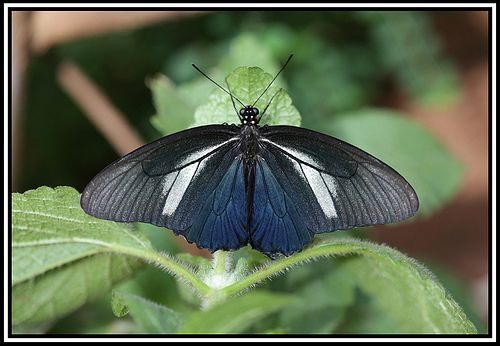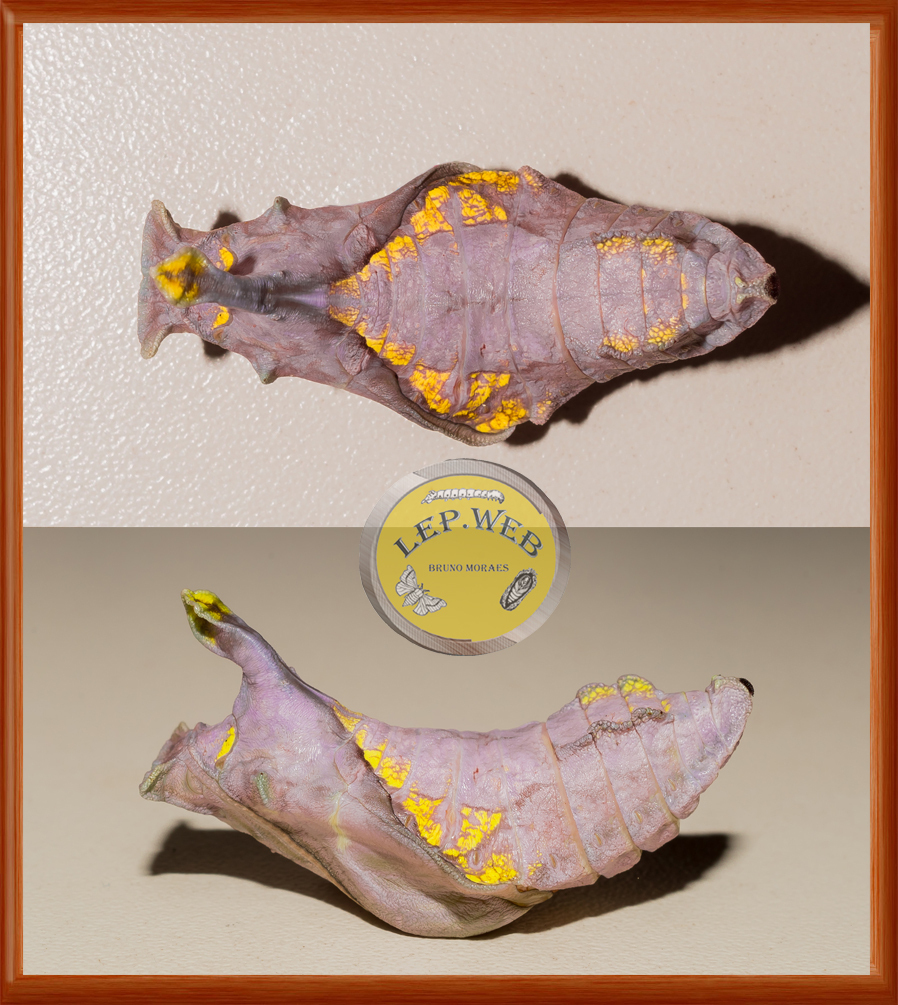As a word crassus means the big, thick, fat, crass, gross, or heavy one of anything, and is the species name of several different kinds of animal. It was also the name of several people in ancient Roman history and literature, apparently a popular nickname for a sturdy muscular man. In the eighteenth and nineteenth century it was traditional to name the large butterflies and moths after characters in ancient literature. Thus Battus crassus is translated as "Crassus Swallowtail," rather than "Crass Swallowtail" or "Big Swallowtail."
It is large, though, for the genus Battus; some individuals' wingspans are over four inches. Its Spanish name translates as "Swallowtail Butterfly of Long Wings."
Sipping from colorful flowers, the butterfly probably has no idea how appealing it is to humans who collect butterfly pictures like modern naturalists. It is, of course, conscious (to the extent that butterflies are conscious of anything) of its appeal to other Crassus Swallowtails. So this one probably was trying to make a pretty picture.
They do some composting--many individuals are photographed at puddles or near overripe fruit--but they are primarily pollinators. One study, not linked here because the site behaved badly, found that the butterflies are able to absorb some amino acids from pollen that sticks to them, though most of the pollen they take from one flower is merely transferred to another flower.
The Swallowtail of Long Wings is found in many South American countries, but it likes a lot of space and is not found very often anywhere. It's not considered an endangered species. There are four subspecies, identifiable by their habitat and by the number and color of stripes on the wings. Butterflies Of America has a web page showing a range of possible color patterns for each subspecies; all photos but the lepidus below are of dead museum specimens.
Battus crassus proper is native to Surinam, found in Brazil to Costa Rica, and has a wide splash of color that usually widens out and breaks off toward the outer edge of the fore wing. There may or may not be a stripe on the hind wings.
B.c. hirundo lives in Bolivia. Its lighter-colored stripes may be merely lighter gray. Its more conspicuous stripes are black across the dark drab wings above and below the white or pale gray stripe.
B.c.. lepidus lives in northeastern South America, from Costa Rica to Venezuela and Ecuador, and usually has only one narrow stripe.
B/c. paraensis lives in Brazil and tends to be drab rather than iridescent, with only one stripe on either the fore wings or hind wings but not both.
Nineteenth century painters were fascinated by the iridescence and painted these butterflies as lovely Victorian velvet work in dark blue, green, and gold. Photos do not suggest that these paintings were very lifelike, but they certainly were pretty. French Wikipedia still prefers one of those paintings to a photo of a living butterfly for their short article on this species, and Bolivia put another old painting on a stamp:
The undersides of the wings may show white stripes or resemble the underside of the Pipevine Swallowtail. Crassus is as toxic, if swallowed, as Battus philenor is, and gets its warning red spots from the same phytochemicals. It is mimicked by a few other South American butterflies, like the less toxic swallowtail Heraclides androgeus and the longwing Heliconius sara..
Here's a blogger's reaction to recognizing the rarer dark female H. androgeus:
Including photos of the mimic species here might be misleading, but here's what they look like:
Androgeus, male (much yellower) and female: https://en.wikipedia.org/wiki/Papilio_androgeus
All Crassus Swallowtails have dark, more or less iridescent wings with stripes that run straight across, almost like museum markings, when a dead specimen is spread out in a museum's display case. Stripes can be white or bright yellow, and be found on the fore wings, the hind wings, or both. It's one of the Swallowtail butterflies that do not actually have the "swallowtails" on the hind wings. Males have visible scent folds on the hind wings, and are more likely to iridesce blue or green than females are. Females often look brown. Bodies are black with various patterns of spots that may be white, yellow, or pale blue.
One source described the Crassus Swallowtail as "seldom collected." Google shows otherwise. About half of the web pages about this butterfly are offering dead bodies for sale. However, the butterfly has been more often collected by amateurs than by serious scientists. Nearly all the web pages about this butterfly as a living species are checklists or picture sites. Only a few scientific studies are available online.
Different subspecies of Crassus can eat as many as eight different species of vines in the genus Aristolochia. These are the South American species of the Aristolochia vines on which the Asian Batwings feed, and some people count Crassus as a Batwing. Like the Atrophaneuras, its wings can look white with black veins in some lights..
The adult butterfly is believed to fly for about two weeks.
Like a Batwing, the caterpillar is described as variably brownish black. I found no photographs of eggs or caterpillars online.
Pupas seem to be camouflaged as dead leaves, like those of the Atrophaneuras, but as a different kind of leaves.








No comments:
Post a Comment